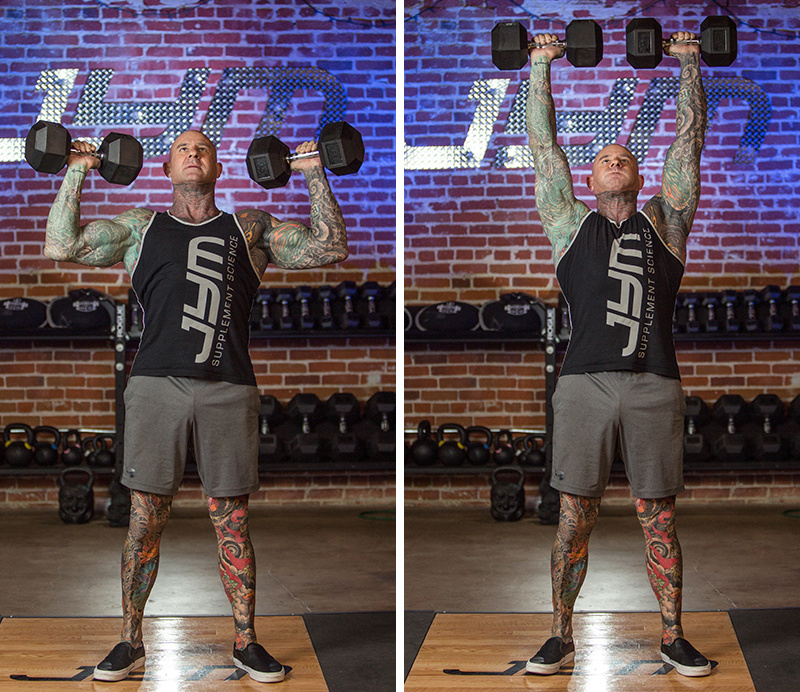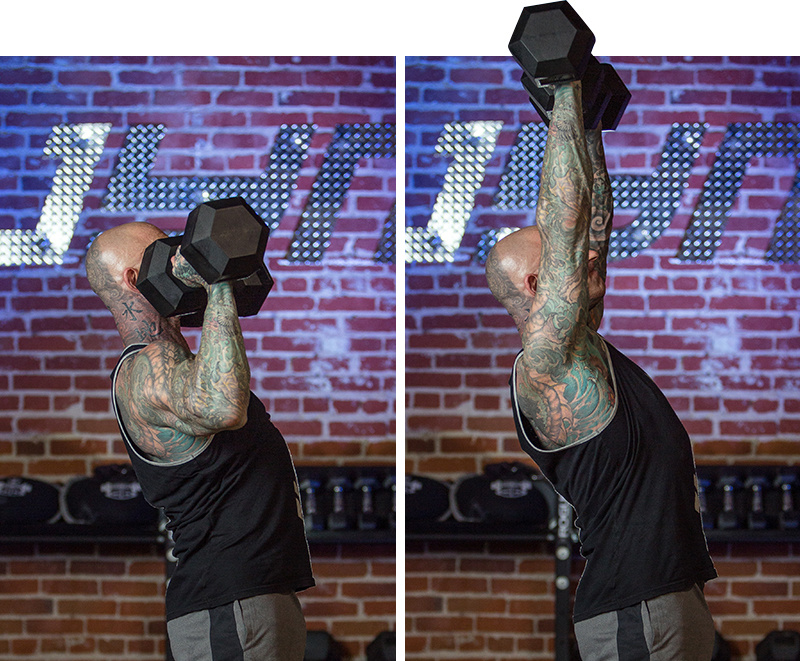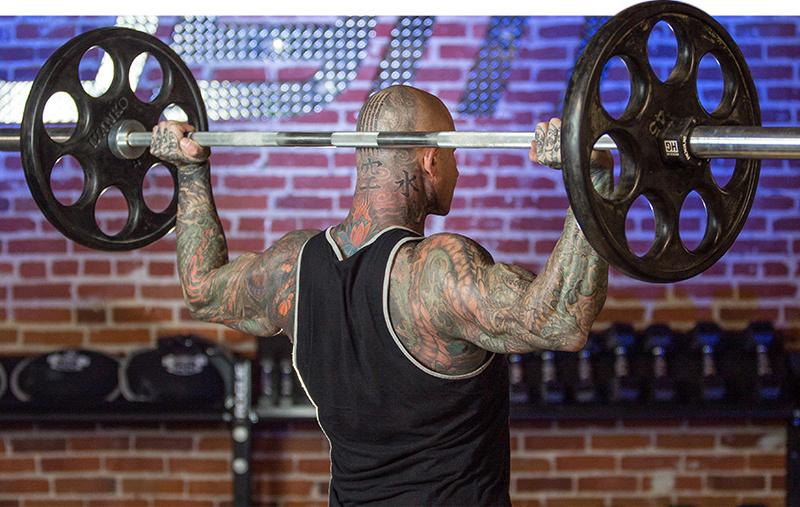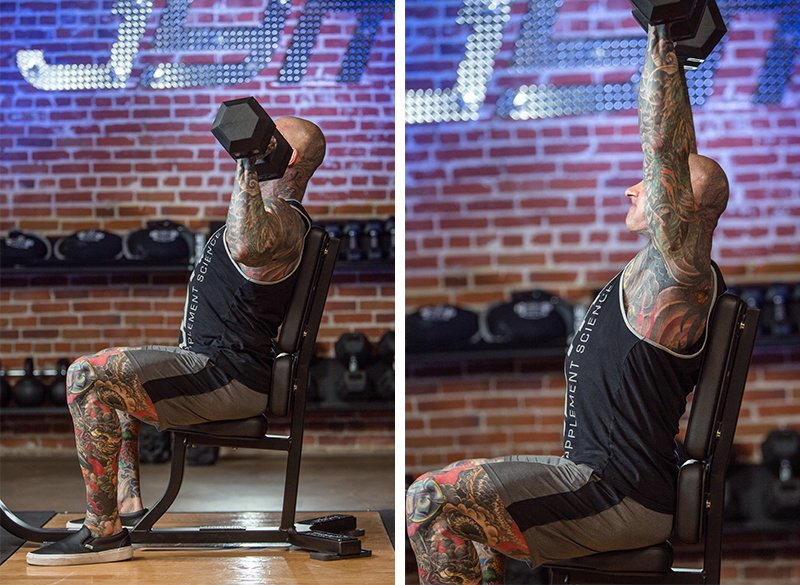How To Do A Shoulder Press
Maximize deltoid size and strength with the best mass-building move there is for shoulders.

Maximize deltoid size and strength with the best mass-building move there is for shoulders.

Note: The above videos were recorded as Facebook Live tutorials in conjunction with Full-Body Shortcut to Size (Video #1) and Tabata Builder (Video #2) programs.
Everybody wants big shoulders, and the shoulder press is without a doubt the ultimate mass-builder for the deltoids. But there are a number of ways you can do this exercise incorrectly and harm not only the vulnerable shoulder joints but even the lower back.
So, in this Master Class, I'm going to cover how to best do shoulder presses for maximum effectiveness and safety.

When talking about shoulders as a body part, the muscle group we’re referring to is the deltoids. The terms “shoulders” and “deltoids” (delts for short) are used interchangeably.
There are three deltoid muscles (or heads) in the shoulder: the anterior (front) deltoids, the middle deltoids, and the posterior (rear) deltoids. When doing shoulder presses, the main heads involved are the front and middle delts, not so much the rears.
Bodybuilders (and anyone who lifts weights a lot) tend to have overpowering front delts compared to middle delts because of all the chest exercises they do. Movements like incline presses and even flat bench press hit the front delts to a large extent, with very little middle delt involvement.
If you want to build wider shoulders, get that good roundness, and achieve those “cannonball delts,” you really need to develop the middle deltoids. You can do that with shoulder presses, provided you do them properly. What it comes down to is elbow position.
Shoulder presses can be performed with the elbows pointed out to the sides or more in front of the body and pointed forward. Elbow position determines deltoid involvement. When the elbows come out to the sides, it’s hitting more middle delt; when the upper arms are in front of the body, it’s emphasizing the front delts more.
Now, just to be clear, the elbows are pointed out to the sides, but they’re still slightly in front of the shoulders and torso, not directly in line with them. You want them slightly forward to protect the shoulder joints from injury. In the below “Setup” section, I’ll get into more detail on how to stabilize the shoulder joints during the movement to minimize injury risk.

So how do we keep the elbows in the right position to target the middle delts? One simple way is to use dumbbells on shoulder presses instead of a barbell.
The problem with barbell shoulder presses is that, when you bring the bar down, your head is in the way. To move the bar in front of your face so that you can keep lowering it, your elbows have to come in front of your body. In this position, the front delts are more involved. If you’re able to keep your elbows out to the sides, though, with barbell presses, keep doing it.
Otherwise, do dumbbell shoulder presses to target the middle delts. With dumbbells, you’re able to flare the elbows out without having to worry about hitting yourself in the head or face or lowering the weight behind your head (more on behind-the-neck barbell presses in a moment). This way, I’m hitting the muscles I want to hit without putting undue strain on my rotator cuffs.
For many people, the only way to keep the elbows out to the sides on barbell shoulder presses is to go behind the head. The problem here is that you get external rotation of the shoulders, which can compromise the rotator cuff and potentially cause problems down the road. In other words, instead of the elbows being slightly in front of the body, they’re rotated further back (in line with, or slightly behind, the body).
That’s why I prefer dumbbell presses. With a barbell, you either have to go in front of the head or behind it. With dumbbells, however, the imaginary line between your hands can literally go right through the middle of your head when lowering the weights, thus allowing you to keep the elbows pointed out to the sides while not externally rotating the shoulders too much. Win-win!
If you do decide to do behind-the-neck shoulder presses, make sure you don't lower the bar below your ears. And keep your neck as straight as possible – don’t flex your cervical spine at the bottom of the rep.

Personally, I prefer to do my shoulder presses standing instead of seated, regardless of whether I’m using dumbbells or a barbell. I prefer standing for a few different reasons…
First of all, standing presses are more functional in everyday life than seated. I’m not jumping on the “functional training” bandwagon by any means, but with standing shoulder presses you are, in fact, using more muscles in the body and burning more calories; research proves that.
Also, when you’re pressing something overhead in real life (like putting a box up on a shelf), you’re standing up, right? Again, I’m not trying to be Mr. Functional Trainer here, but it’s good to consider real-world carryover when choosing exercise variations.
You’re also engaging the core to a greater degree when standing versus sitting. I know a lot of people hate talking about the core – because everyone talks about core training, even people who have no idea what they’re talking about! – but it’s an important factor for overall fitness, health, and even strength.
To take the concept even further, research shows that the one-arm dumbbell shoulder press (where your non-working hand is not holding a dumbbell) is a great core exercise because it puts you in an unbalanced position and forces those muscles to work harder. I don’t prescribe one-arm dumbbell presses all that often in my programs, but if you want to focus on core strength, definitely consider subbing that in wherever I list dumbbell shoulder press in a workout.
The most important benefit of standing versus seated for me is that it provides more cushioning for my lower back. I used to race motocross as a teenager and I had a bad accident, so I have some pretty serious back issues in my lumbar spine. A lot of people assume that sitting would take pressure off my lower back, but this isn’t the case.
When doing seated shoulder presses, you’re able to use more weight because your upper body is supported. You might think that’s a good thing, but if you have lower back issues it’s not. A lot of the force from that weight is being absorbed by the spine and into the sacrum and pelvis. The seat provides no give, so it absorbs none of the force.
When standing, however, the legs, hips, knees, and ankles all act as shock absorbers and take some of the load. (As opposed to seated, where your lower body is totally eliminated from helping absorb any force.) This greatly reduces the stress on the spine/lower back. And not just on shoulder presses; where the lower back is concerned, standing is better than seated on dumbbell lateral raises and dumbbell curls as well.
Not only are standing presses good for taking pressure off the spine; the exercise is also good for strengthening the lower back muscles (spinal erectors). When people say standing presses hurt their lower back, it’s often because those lower back muscles are weak. And you don’t want to avoid strengthening them by always doing seated presses – in that case, the bench or seat becomes your crutch for weak spinal erectors. Don’t forget, those lower back muscles are part of the core, and we know that standing shoulder presses are great for strengthening that area.
That said if you don’t have lower back issues and you prefer to do shoulder presses seated, at least make sure your torso is fully upright. When using a low-back seat, especially when going heavy, a lot of people will let their butt slide forward on the seat so that they’re leaning way back. At that point, you’re basically doing an incline press. Same thing when using an adjustable bench and you adjust the seat back so that’s one or two clicks down from fully upright; it’s more like an incline press, and it’s hitting the front deltoids to a larger extent.
Not that the incline press is a bad exercise, of course. But if it’s shoulder day and the goal is to hit the middle delts, keep your torso vertical. If using an adjustable bench, have it set to a 90-degree angle, not leaned back.

One last point on seated shoulder presses: Even though it’s not my preferred version of the exercise, it is without a doubt the best way to overload the middle delts for maximum shoulder size – provided you maintain that nice upright torso position. Because you’re supported by the seat or bench, you’ll be able to use more weight, and more weight equals more overload.
Personally, my goal isn’t to maximize my shoulder size, so that’s why I prefer standing presses. But if delt size is your main objective, go ahead and do seated presses, staying cognizant of both your lower back and shoulder health.
I talk often about the benefits of using an open grip (thumb on the same side of the bar or dumbbell handle as the fingers, as opposed to wrapped around the bar) on bench press and lat pulldowns, and it’s also effective for shoulder presses.
On this exercise, the open grip keeps the bar/handle lower in the palm, down by the meat of the hand versus up near the knuckles. When it sits lower like this, the weight is directly over the forearm bones, which makes for a stronger press. Being directly over the forearms makes for a more direct line of force, where you’re pressing into those handles and straight up. The higher up in the hand the handle is, the further away it is from the forearm.
If you’re worried the weights my slip out of your hands with the open grip, I highly recommend wrist straps (I like the Versa Gripps brand, personally). You should have straps for pulling exercises anyway, so use them on shoulder presses as well just in case the handles or bar slips out of your hand. In the Shoulder Press video #1 above, I show you how to use the Versa Gripps on shoulder presses at the 19:00 mark.
Getting in the proper position on shoulder presses is critical for keeping the movement safe.
As I mentioned above, your elbows should start out slightly in front of the body and stay that way throughout the movement. If they come too far back, you’ll be compromising your shoulder joint health.
Aside from elbow position, you need to lock your shoulders into place to keep the movement safe and effective. To do this, pull your shoulder blades together by contracting your middle traps and rhomboids; that’s going to stabilize the shoulder joints. To provide further support, contract the lats as well.
Go somewhere around shoulder-width for your grip. This applies more to a barbell press, but this should also give you an idea of how wide to have your hands when using dumbbells. And again, go with an open grip.
If you’re doing standing shoulder presses, you’ll first need to get the weight up to your shoulders. You can do this by performing a clean before your first rep. Or, if you’re doing barbell shoulder presses and you don’t want to clean the weight, you can set the bar up at shoulder height in a power rack and grab it from there.
The motion here is pretty straightforward: Press the weight straight up overhead. That said, your exact range of motion on shoulder presses will vary somewhat depending on what version of the movement you’re doing.
When you come down, lower the bar or the handles of the dumbbells to below chin level; if using a barbell, you’ll be bringing it down to your collarbones.
Now, you may have heard people say to only go down to ear level. Well, yes and no. Stopping at ear level is what I advise for behind-the-neck presses or if your hands are well outside shoulder-width (either with a bar or dumbbells); going below that puts undue stress on the rotator cuffs due to excessive external rotation. Basically, when the elbows are back and in line with your torso, you need to be more careful about not bringing the weight down too far.
When your elbows are in front of the body, however, coming down below the chin is fine.
Locking out the elbows at the top is not only unsafe for your joints, but it’s also unnecessary for maximizing middle delt involvement. The only thing locking out the elbows does from a muscular standpoint is increase the contraction in the triceps. But this is an exercise for the shoulders, not the triceps. Save the elbow lockout for pushdowns and extensions.
To absorb the weight in your lower body (not your spine and lower back), keep a slight bend in your knees throughout the movement.
Other than that, keep those shoulders locked into position and press the weight with authority overhead.
Find the dumbbell shoulder press on Day 3 (shoulders and traps focus) of all four weeks of my Full-Body Shortcut to Size program. Barbell shoulders presses can be found on Day 3 (shoulders and traps) of Tabata Builder.
Related Articles